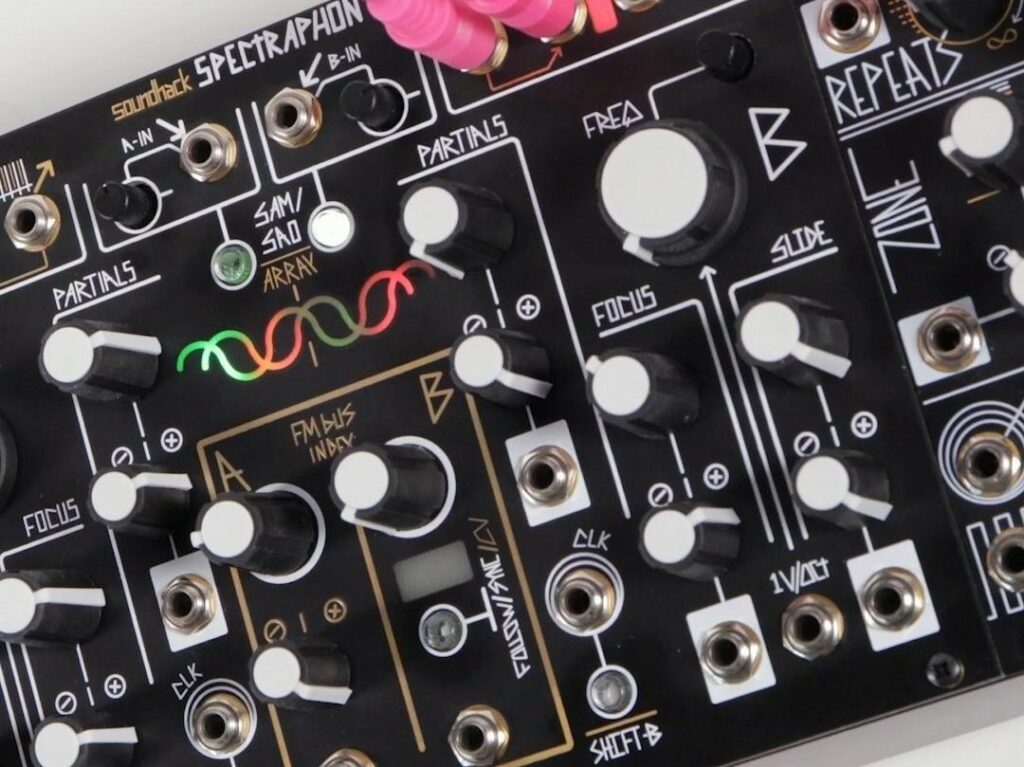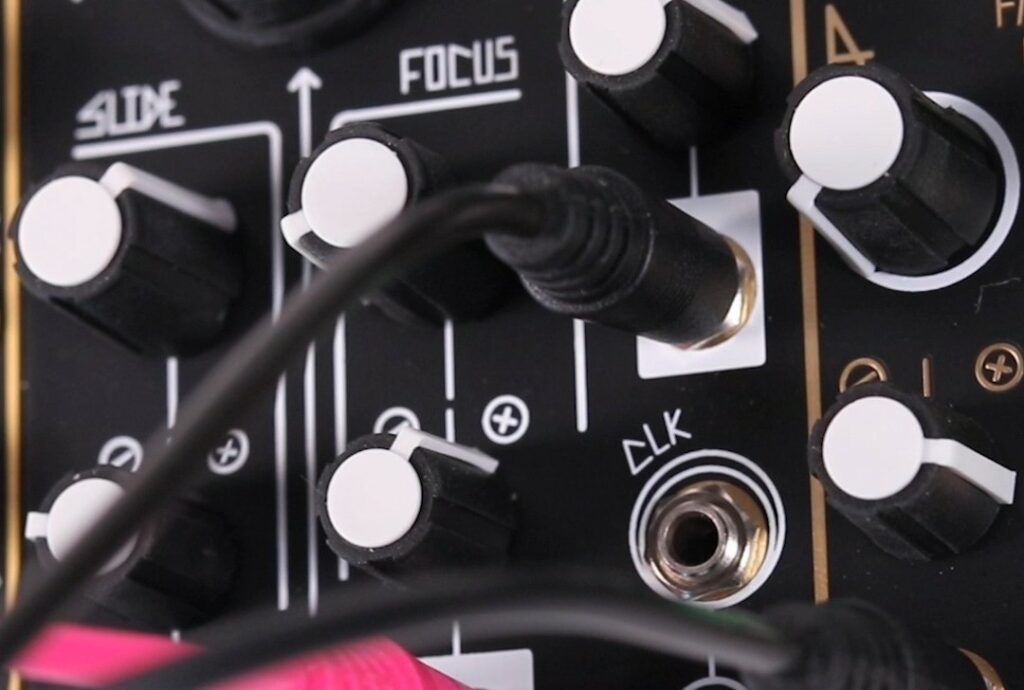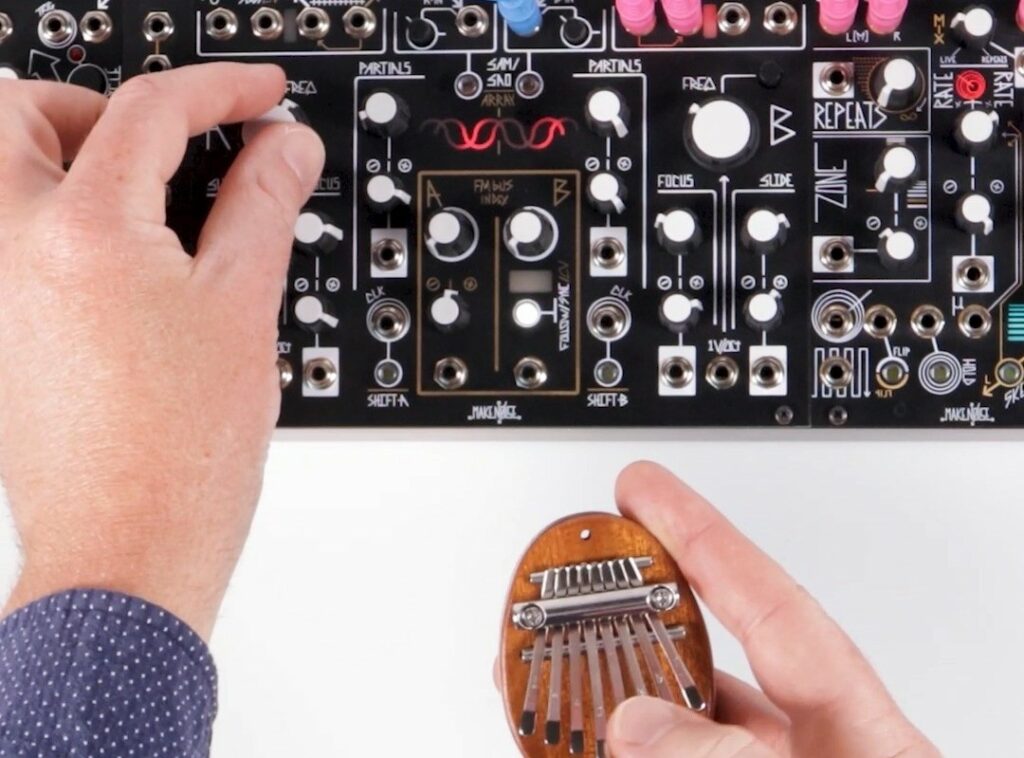Combining old-school techniques with cutting-edge digital synthesis, Make Noise’s latest collab with Soundhack represents the pinnacle of the brand’s DSP power. Greg Scarth puts this unique oscillator to the test.

The new Make Noise/Soundhack Spectraphon isn’t the first collaboration between the North Carolina hardware brand and software developer Tom Erbe. Previous collabs between the two include the excellent Morphagene Tape Slice module and Erbe Verb reverb. The Spectraphon is, however, the first module to take advantage of Make Noise’s new DSP hardware, a two-input, eight-output platform with low noise, high dynamic range and 24-bit/192 kHz processing. High hopes, then, for this unique dual spectral oscillator, which draws on old-school Buchla sounds as well as the latest DSP tech.
Unlike plenty of Make Noise’s other modules, the Spectraphon doesn’t rely on symbols to mark the function of many controls or connections. In fact, most of the features and functions here are pretty self-explanatory assuming you’re familiar with an oscillator (and even more so if you’ve used a complex oscillator like the Endorphin.es Furthrrrr Generator). Make Noise refer to the left and right-hand sections as Side A and Side B rather than Osc 1 and 2, but otherwise you’re looking at two almost identical digital oscillators, both of which operate independently but also interact with each other. Core controls for each Side handle frequency, Slide, Focus and Partials, all with the option of CV inputs. The way the Slide and Focus controls works depends on the mode of the Side (more of which later), but Partials adjusts the number of partial harmonics at each of the outputs, which can be split into odd and even harmonics using the two sockets, but the even output is normalled to the odd output to provide a mixed signal when only the odd output is patched.

The two modes of the Spectraphon are quite similar but fundamentally different in the way they work and, therefore, the kind of sounds they create. Spectral Array Oscillation (SAO) mode is the less complicated of the two, which makes it a good starting point to get to understand some of the controls and signal path. With a Side in SAO mode, the DSP generates a continuous waveform based on Arrays of spectra stored in memory, which you could think of as the equivalent of different wave shapes for a digital oscillator. You can actually have up to 1024 spectra for each Array, which makes the Spectraphon’s oscillators a bit like the spectral equivalent of a wavetable synth. In SAO mode, the Slide and Focus controls are used to select spectra from the current Array, giving filtering and PWM-style effects when adjusted, depending on the nature of your spectra. The Partials control works vaguely similar to a low-pass filter combined with a level control, closing down and opening up the harmonics of the signal. Meanwhile, the central FM Bus allows you to perform precise frequency modulation from one Side to the other. Even if that was the extent of the Spectraphon’s power, it would be an excellent digital complex oscillator, but there’s much more to it than that.

With the basics of SAO mode figured out, you can then attempt the slightly more complex Spectral Amplitude Modulation (SAM) mode. SAM isn’t a continuous oscillation like SAO, but a real-time analysis and resynthesis of the spectrum at the input, vaguely similar to a vocoder (which it can do a decent version of with a voice routed into the input) but more similar to exotica like the Buchla 296 Spectral Processor and Touché synth. With no input present, there’s no output from SAM mode, but when you play a signal into a Side in SAM mode, the Spectraphon will analyse its harmonic content and modulate the amplitude of the harmonics sent to the output, at your chosen frequency. The Slide control determines the fundamental frequency for analysis of the input signal, while the Focus control sets the size of the range of harmonics. Pitch, FM and Partials all work the same as in SAO mode. So, where do you start with your input signal? The Mutable Instruments Plaits feels like a good idea, and immediately you get a sense of the unusual effects this module can create; dialling through different settings on the Plaits, what comes out of the Spectraphon is a warped, mutated version depending on oscillator settings. It’s clear that there’s a relationship between the two, but it’s like the Spectraphon is chewing up the Plaits sound and spitting out its own take, especially when you start to adjust the parameters of the two modules against each other, such as changing the timbre of the Plaits patch while playing different frequencies on the Spectraphon.

The sound of the Spectraphon is about as open-ended as it gets. Depending on the source material, you can create a huge range of sounds in both SAO and SAM modes. There’s a temptation to reach for that hugely effective FM Bus and add clangy metallic modulation, but that can be reined back in with the Partials control. The separate odd and even harmonic outputs for each Side provide plenty of opportunities to set up stereo patches or crossfade between different outputs. There are a wealth of further options to explore, starting with the fact any combination of SAO and SAM mode can be used for the two Sides, giving you four different combinations to choose from. Side B can Follow or Sync to Side A, with Follow turning the B Pitch control into an offset from A Pitch and Sync adding conventional hard sync. Sub/CV outputs can be used as envelope followers, sine/saturated saw sub oscillators or clocked modulation outputs. You can also create your own Arrays of spectra by recording an input source. The Spectraphon can store up to 1024 spectra per Array, either by recording a sample at each clock input, or by recording samples automatically over the course of just over a second. You can approach this in a few different ways, either by planning ahead for the kind of spectra you want and creating an Array accordingly, or simply by sampling a snippet of incoming audio and repeating until you get interesting results. The Spectraphon lends itself very much to experimentation and random, unexpected outcomes. It’s also worth pointing out the clever visual feedback from the Tuning Beacon in the FM Bus (which indicates tuning intervals between Side A and Side B) and the Array Binary (which shows the current Array as a four-bit binary number).

A major Make Noise release is always a big deal, and the Spectraphon is no exception. Despite its depth and complexity, this is a surprisingly intuitive module to get started with, particularly if you approach SAO mode first and get the hang of some of the routing and modulation options before approaching the slightly more complex real-time options of SAM mode. At £559, it’s a fairly pricey module, but you’re getting a hell of a lot for your money and there aren’t really any direct alternatives. Rossum Electro-Music’s Panharmonium Mutating Spectral Resynthesizer has a related approach, but really the Spectraphon is unique. All that’s left is for us to wander what Make Noise and Erbe might cook up next with this powerful new DSP platform.
Greg Scarth
More info/buy